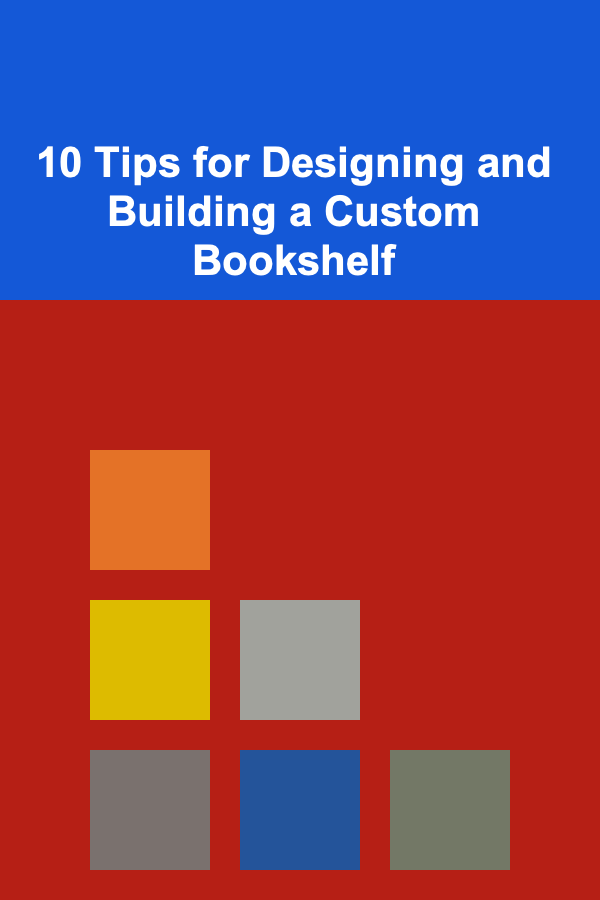
10 Tips for Designing and Building a Custom Bookshelf
ebook include PDF & Audio bundle (Micro Guide)
$12.99$8.99
Limited Time Offer! Order within the next:

Designing and building a custom bookshelf is one of the most rewarding and satisfying DIY projects for anyone looking to enhance their living space. Not only does it add functionality and organization to a room, but it also allows for personalization, creating a unique piece of furniture that matches your style, tastes, and space requirements. Whether you're an experienced woodworker or a beginner, the process of building a bookshelf can be an enjoyable experience with the right guidance.
In this article, we'll explore 10 essential tips for designing and building your own custom bookshelf. These tips will cover everything from planning your design to selecting materials, constructing the bookshelf, and finishing touches. Whether you're building a small bookshelf for your home office or a large built-in unit for your living room, these tips will help ensure your project is both successful and beautiful.
Start with a Clear Plan
Before you dive into building your bookshelf, it's crucial to have a clear plan. This includes deciding on the bookshelf's dimensions, design, and purpose. Here are a few key questions to consider when planning your custom bookshelf:
- What will the bookshelf be used for? Are you storing books, displaying decorative items, or organizing media equipment?
- What space will it occupy? Measure the available space to ensure that your bookshelf fits perfectly into the designated area.
- What aesthetic are you going for? Do you want a modern minimalist look, a rustic style, or something more traditional?
Sketching out your design on paper or using design software can help you visualize your bookshelf and make necessary adjustments before you start building.
Tip:
If you're unsure about your design, check out online resources for inspiration. Websites like Pinterest and Houzz can provide ideas based on your space and style preferences.
Choose the Right Materials
The materials you choose will affect the look, durability, and cost of your bookshelf. Consider the following when selecting materials:
- Wood: Solid wood, such as oak, pine, or walnut, is a popular choice for bookshelves due to its strength and timeless look. However, solid wood can be expensive.
- Plywood: Plywood is a more affordable option and is sturdy enough for most bookshelves. It can also be finished with a veneer to give the appearance of solid wood.
- MDF (Medium Density Fiberboard): MDF is another budget-friendly option that can be easily painted. However, it is less durable than solid wood or plywood and may not be suitable for heavy books.
- Metal and Glass: For a more modern or industrial look, consider using metal brackets or glass shelves. These materials are durable but can be more challenging to work with.
Tip:
For a more sustainable project, consider repurposing old furniture or reclaimed wood. This can add a unique touch and reduce the overall cost of the project.
Select the Right Tools for the Job
Having the proper tools is essential for creating a professional-looking bookshelf. Here are the basic tools you'll need for this project:
- Measuring Tape: Accurate measurements are crucial for building a bookshelf that fits perfectly in your space.
- Saw: A circular saw or table saw is ideal for cutting wood to the desired dimensions. A miter saw is also useful for making precise angled cuts.
- Drill: You'll need a drill to create pilot holes for screws or bolts.
- Screws and Wood Glue: Use screws to secure the parts of the bookshelf together. Wood glue can provide additional strength and stability.
- Sander: Sanding your bookshelf's surfaces will give it a smooth, polished finish.
Tip:
If you don't have access to certain tools, consider renting them from a local hardware store or borrowing from a friend.
Plan for Adjustable Shelves
One of the key benefits of designing a custom bookshelf is the ability to customize it for your needs. Consider adding adjustable shelves to your design. This flexibility allows you to modify the shelf height based on the size of your books or other items you plan to store. Adjustable shelves are easy to build and can be added later if you decide to upgrade your bookshelf.
Tip:
To make adjustable shelves, use shelf brackets or metal tracks. This will allow you to move the shelves up and down without the need to drill new holes.
Take Weight into Consideration
Bookshelves often need to support heavy items, especially if you plan to store a large number of books. Make sure your design takes into account the weight of the books or other items you plan to store.
- Thickness of Shelves: Thicker shelves can support more weight. Consider using at least 1-inch thick wood for the shelves if you plan on storing heavy books.
- Reinforcement: If you're concerned about the shelves sagging, consider adding additional supports underneath or using metal brackets for reinforcement.
Tip:
If your bookshelf will hold particularly heavy items, consider using a more substantial material, such as plywood or solid wood, for the shelves and frame.
Incorporate Cable Management (If Necessary)
If you plan to store media equipment, such as televisions, gaming consoles, or stereo systems, consider adding cable management features to your bookshelf design. This can include cable holes or channels that help keep cords organized and out of sight.
Tip:
You can also create compartments for storing remote controls, gaming controllers, or other small items that can easily get lost.
Factor in Finishes and Aesthetics
A bookshelf's finish is as important as its structure. Choose a finish that complements the overall look of the room and adds to the bookshelf's durability. Here are a few common finishes:
- Paint: Painting your bookshelf can provide a smooth, uniform appearance. Use a primer and several coats of paint for the best results.
- Stain: Staining wood can highlight its natural grain and add warmth to your bookshelf. Make sure to apply a clear finish over the stain for added protection.
- Varnish or Polyurethane: These finishes offer a glossy, durable coating that protects the wood from scratches and spills.
Tip:
Test your finish on a scrap piece of wood to ensure it achieves the look you want before applying it to your bookshelf.
Ensure Proper Support and Anchoring
Bookshelves, especially larger ones, can become top-heavy if not properly anchored to the wall. This can result in the bookshelf tipping over, which can be dangerous. To prevent this, make sure your bookshelf is securely attached to the wall using brackets or anchors.
- Wall Anchors: Use wall anchors if your bookshelf is particularly large or if you're storing heavy items.
- Built-in Supports: For a built-in bookshelf, make sure the frame is securely attached to both the floor and the wall to provide added stability.
Tip:
If your bookshelf is freestanding and not anchored, ensure that the shelves are evenly spaced and that the frame is solid to prevent tipping.
Take Your Time
Building a custom bookshelf can be a time-consuming process, especially if you're new to woodworking. It's important to take your time and focus on getting each step right. Cutting wood, drilling holes, and assembling the pieces requires patience and precision.
- Measure Twice, Cut Once: Double-check all of your measurements before cutting. This will help prevent costly mistakes.
- Don't Rush: Take breaks if you feel tired or frustrated. Rushing through the process can lead to mistakes that may compromise the quality of your bookshelf.
Tip:
Set aside a dedicated space for your project, and avoid trying to complete everything in one day. Spread the work over several days to ensure you're not rushing through any steps.
Personalize Your Design
Finally, remember that this is your bookshelf, and it should reflect your personal style. Customize the design with unique touches that make it stand out:
- Color: Choose a color that complements your décor.
- Carvings or Inlays: Add decorative carvings or inlays to create a more intricate design.
- Lighting: Incorporating built-in lighting can highlight your books or display items on the shelf.
Tip:
Think about how you want to use the space around your bookshelf. Adding decorative accents or integrating the bookshelf into your existing furniture can elevate the overall look.
Conclusion
Designing and building a custom bookshelf is a rewarding project that offers both practical benefits and creative satisfaction. By following these 10 essential tips, you can ensure that your bookshelf is not only functional and sturdy but also a unique reflection of your personal style. Whether you're an experienced woodworker or a novice, taking your time to plan, choose the right materials, and execute each step carefully will result in a beautiful and functional addition to your home.
Happy building!
Reading More From Our Other Websites
- [Organization Tip 101] How to Create a Baby or Nursery Inventory
- [Tiny Home Living Tip 101] Best Minimalist Decorating Trends for Tiny Home Aesthetics
- [Star Gazing Tip 101] Night Sky Adventures: Family‑Friendly Stargazing Destinations and Tips
- [Personal Finance Management 101] How to Create a Financial Plan for Your Freelance Business
- [Polymer Clay Modeling Tip 101] How to Create Miniature Polymer Clay Architectural Models with Accurate Scale Details
- [Skydiving Tip 101] Best Methods for Maintaining Parachute Fabric Integrity in Humid Environments
- [Home Soundproofing 101] How to Soundproof a Shared Wall with a Neighbor
- [Beachcombing Tip 101] Best Early‑Morning Beachcombing Spots for Finding Rare Sea Glass in the Pacific Northwest
- [Organization Tip 101] How to Manage Seasonal Family Activities with Effective Planning
- [Personal Care Tips 101] How to Select the Right Hair Gel for Men

How to Access Quality Free Educational Resources for Self-Improvement
Read More
How to Maximize Your Rental Property's Return on Investment (ROI)
Read More
How to Organize Your Craft Room with Multi-Functional Furniture
Read More
How to Prepare Your Home for Seasonal Changes
Read More
How To Choose the Best Period Dramas for Historical Detail
Read More
Diving Deep into the History of Disco
Read MoreOther Products

How to Access Quality Free Educational Resources for Self-Improvement
Read More
How to Maximize Your Rental Property's Return on Investment (ROI)
Read More
How to Organize Your Craft Room with Multi-Functional Furniture
Read More
How to Prepare Your Home for Seasonal Changes
Read More
How To Choose the Best Period Dramas for Historical Detail
Read More